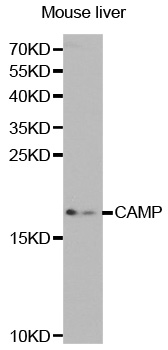
IHC-P analysis of human spleen tissue using GTX85418 Cathelicidin antibody. Working concentration : 5 microg/ml
Cathelicidin antibody
GTX85418
ApplicationsWestern Blot, ELISA, ImmunoHistoChemistry, ImmunoHistoChemistry Paraffin
Product group Antibodies
TargetCAMP
Overview
- SupplierGeneTex
- Product NameCathelicidin antibody
- Delivery Days Customer9
- Application Supplier NoteWB: 1 microg/mL. IHC-P: 5 microg/mL. *Optimal dilutions/concentrations should be determined by the researcher.Not tested in other applications.
- ApplicationsWestern Blot, ELISA, ImmunoHistoChemistry, ImmunoHistoChemistry Paraffin
- CertificationResearch Use Only
- ClonalityPolyclonal
- Concentration1 mg/ml
- ConjugateUnconjugated
- Gene ID820
- Target nameCAMP
- Target descriptioncathelicidin antimicrobial peptide
- Target synonymsCAP-18, CAP18, CRAMP, FALL-39, FALL39, HSD26, LL37, cathelicidin antimicrobial peptide, 18 kDa cationic antimicrobial protein, epididymis secretory sperm binding protein
- HostRabbit
- IsotypeIgG
- Protein IDP49913
- Protein NameCathelicidin antimicrobial peptide
- Scientific DescriptionOne component of host defense at mucosal surfaces is epithelial-derived antimicrobial peptides. Cathelicidins are one family of antimicrobial peptides characterized by conserved pro-peptide sequences that have been identified in epithelial tissues and some myeloid cells of humans and animals. LL-37/hCAP-18 is the only Cathelicidin found in humans and is expressed in inflammatory and epithelial cells. The presence of these molecules is essential for defense against invasive bacterial infection in skin. Besides their direct antimicrobial function, Cathelicidins have multiple roles in mediating innate and adaptive immunity, such as endotoxin neutralizing, angiogenesis, wound healing and promoting neutrophil chemotaxis and mast cell recruitment. Finally, Cathelicidin antimicrobial peptides qualify as prototypes of innovative drugs that may be used to treat infection and/or modulate the immune response.
- Storage Instruction2°C to 8°C
- UNSPSC12352203








